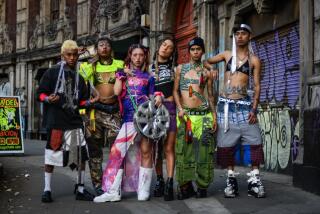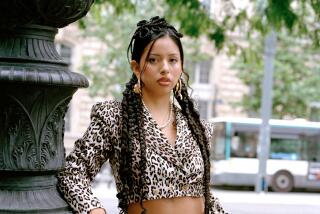ART : Cultural Concepts : Celia Munoz draws on her childhood and heritage to tell stories in challenging, conceptual multimedia works
- Share via
LA JOLLA — “Once, I thought that being a Catholic Chicana from El Paso were three strikes against me. Now, that is precisely where I draw my material.”
Celia Alvarez Munoz has spoken and written these words many times over her career of the last 10 years, and they seem to sum up the dilemma that she continues to face. While the art world encourages individualism, being too different can leave one on the outside. Fashions tend toward generalizations, artists fit into schools, groups, trends.
Munoz says other artists have told her that to present strictly autobiographical material is to challenge the artistry of art. To draw upon personal experience is to undermine the impersonal generalities of much contemporary art.
But Munoz has had no patience with other people’s directives, having only decided to become an artist at age 42, in 1979. She was a mother of two pre-teen-agers and the wife of a successful civil engineer, but she decided to add a new career to her suburban existence in Arlington, Tex., a place that is halfway between Dallas and Ft. Worth and exactly nowhere in terms of culture.
With two careers already behind her--a brief stint as a fashion illustrator in El Paso and years of teaching art to grade school kids--she enrolled as a printmaker in a graduate art program at North Texas State University in nearby Denton.
Four years later, she began to exhibit narrative, somewhat conceptual, photography-based multimedia work that was accomplished, distinctly personal and very bicultural: “I was exposed to embarrassment one sunny afternoon,” she wrote in a text for “ Ave Maria Purisima , Enlightenment Series No. 8,” a work from 1983. The text goes on to tell the story of how, after a childhood bath one day, her mother forgot to dress her in underwear. While playing outside, the wind blew her skirt up.
“ Ave Maria Purisima! “ a neighbor woman screamed at the sight.
“I wouldn’t go outside until mother gave me another bath,” the story ends.
To make this story more than just an anecdote, Munoz added a twist: In the style of a short film-strip, each sentence of text is accompanied by a sharp-hued color photograph.
The first five pictures show a shiny red apple progressively reducing to a core as bites are taken out of it by an unknown person. The last frame displays a twisted snake above the text describing her girlhood shame. It is an intentionally ironic reference to the Garden of Eden and the superstitions of her protected youth.
“I remember feeling very ashamed by that experience,” she said in a recent interview, walking through her current show at the San Diego Museum of Contemporary Art in La Jolla. “It was difficult at first to make these works. The combination of word and image, pulling from the past and having the nerve to use your own past and not being too redundant. And not becoming too personal like some of the feminist stuff,” she remembered.
“How personal can you get? That was the question.”
Pretty personal, in Munoz’s case. Though her childhood was protected, she was independent and curious, then, as now. Mischief seems to have been a primary activity. The stories are all true, with minor variations for poetic effect.
For a 1983 book, she wrote: “I had been told that when water was changed into wine, it became the Sangre de Christo, the blood of Christ. Wondering what would happen from sampling this miracle water, I helped myself to some. One sip led to, heaven knows, how many more.”
Talking about her art, Munoz is pensive, but straightforward. At moments, the devilishness that dominates the works comes through in her smile. As she talks, the 53-year-old woman appears younger and younger; her growing success has served her well. With long, permed and hennaed hair, dressed in a long gray shirt, gray jeans and knee-high cowboy boots, she seems much more relaxed than she did a decade ago, when she was just starting out.
She still has a touch of the suburban woman, but she’s definitely a mature and politicized Chicana who clearly and confidently thinks of herself as an artist. Her talk flutters between things she’s working on and upcoming shows. Her commitment to personal narrative is now bringing her considerable success. Her small but challenging solo show at the museum in La Jolla, which continues through June 2, will be followed later this spring by a solo show at the Dallas Museum of Art. She also will show works in this year’s Whitney Biennial of American Art in New York, and she has had solo shows at the Lannan Museum in Lake Worth, Florida (1988), New Langton Arts in San Francisco (1989), and the Bridge Center for Contemporary Art in El Paso (1989).
Her rich and varied subjects always involve her childhood, and Munoz said that she sometimes worries about running out of material. “But there’s more,” she laughed. “There’s my teen years . . . .”
The subjects of her works may be specific, but they also have larger implications. They’re mostly about growing up in a sorority of older women, in a house with her aging and superstitious grandmother, her mother, her aunt and, just incidentally, a carefree uncle married to her aunt. Her grandmother spent most of her life combining religious and secular activities; the garden, for example, was to provide fresh flowers daily for the family altar. Her mother worked as a seamstress, as a clerk in a dry cleaners and other jobs. And her aunt loved to have fun, to go dancing in nearby Juarez, across the border from their El Paso home. Her father was away, at war.
Munoz’s life was restricted, but she remembers it was happy. When she went to school and had to confront differences--from the Anglos who spoke English--and from the richer kids, she began to understand the concept of contradiction. Today, the contradictory nature of life, the clash between cultures, between the known and the unknown, is at the heart of her work.
In graduate school, Munoz studied with painter Vernon Fisher, an artist whose narrative works have consistently influenced Munoz’s, particularly some of her current large-scale installations like “El Limite,” which dominates the entry to the La Jolla show. But before that, she was a printmaker, influenced by seeing an exhibition of Jose Guadalupe Posada’s turn-of-the-century journalistic prints at the Amon Carter Museum in Fort Worth. “There was this image of a derailment, a news illustration, in the show,” she remembered. “My grandmother was in a train derailment, and it really hit me.”
But it wasn’t only Posada’s subject that struck her and changed her work permanently.
“He not only illustrated, he wrote in verse. He wrote the news in verse . And it was just like the verse that grandmother would use when she told the stories,” Munoz said.
That print show gave Munoz the license she was searching for. She felt tied to Posada’s method, to his Mexican heritage, and she began to look inside herself.
But unlike other Mexican-American artists who have recently been gaining national attention, Munoz adapted her lessons from the past--and from her own past--in a singularly contemporary ironic style. She didn’t make altars or folk images, though she often incorporated those elements into her work. She used her past, but looked at it through a microscope, always maintaining distance. As such, her work is more like the narrative genre of Fisher or photographer Duane Michals, whose work she had admired in exhibitions and books. Michals, in particular, also recreates autobiographical narratives, and it is to him that Munoz admits she is the most indebted.
Recently, in works like “Ella y El,” (Referentes No. 8) (“She and He”), (1988), she’s begun to expand on her formula of combining photographs and text, and of drawing only upon personal history. And she’s added found objects to the works. “Ella y El” is a cabinet, divided in half between boys’ things--pen knives little pocket treasures--and girls’ things--ribbons, beads and milagros, hearts. The story is one of romance telling of a couple with different interests meet.
And the mixed-media installation “Lana Suve, Lana Baja” (1988), doesn’t have any directly personal narrative at all. Two painted blow-ups of snapshots: one of a small Mexican stucco home decorated with Christmas ornaments and the other of a large two-story coastal wooden home in summer, are accompanied by a row of suspended street signs. The work is meant to describe the way even street names are adopted and Anglicized--or Mexicanized: North Marteens St. is paired with South Martinez. North Myrtle is paired with South Muertos. It is an allegory for life on the border, for divisions that persist between people of different tongues and different backgrounds. With the work, Munoz has includes the English and Spanish text of a jump-rope jingle.
Most recently, she’s turned to her father, long absent during her childhood. He is the subject of a large installation at the La Jolla museum, and he even participated in the process of creating the piece.
“Stories by Dad came from 2 sources; invented and real life adventures. At times hard to separate or distinguish,” she wrote for a printed text that dominates the left side of “El Limite,” a room-sized installation.
“ En las Arenas , near the railroad tracks, they played with toys made out of things that don’t belong together. Like combinations we were warned against.
“ Nunca, never, eat watermelon during a certain time of the month.
“ Nunca, tome leche cuando coma pescado (Never drink milk with fish).
“ Nunca, tome un helado cuando ajitado “ (Never have a cold drink when agitated).”
Just above these words is the image of a child’s toy train made from sardine cans. Her father made these trinkets, recreating the activities of his youth. Inside each sardine can, he placed something different. A couple of branches, a can of condensed milk, stones. This simple paternal arrangement defiles the lessons of her maternal superstitions quoted in the text.
A second picture to the right contains the front of the train, with its tin-can engine, and the rest of the story:
“Some stories stemmed from trips to the Golden State on trains, he jumped on in El Paso, during the Depression years. My favorite stories dealt with the war when he was moved across the world and throughout Europe, again, mostly by train. Little do we know that colic couplings may become the main ingredient to survive.”
All around these 10-times-larger-than-life photos, Munoz has painted the gallery walls yellow, ornamented them with elaborate renderings of her father’s initials and a painted reproduction of Posada’s train derailment.
The text appears stream of conscious, open, without a finish. It’s hard to know what it means, and Munoz is unwilling to provide any concrete answers. This impermanent--it will be eliminated once the show is over--varied work is just one step in Munoz’s latest adventure: Where earlier she supplied all the answers, making her stories tight and finished, now she is leaving open more questions.
“We like surprises, all down to the very end of the process,” she said very deliberately.
“I give you a lot of logic and then I take it away.”
More to Read
The biggest entertainment stories
Get our big stories about Hollywood, film, television, music, arts, culture and more right in your inbox as soon as they publish.
You may occasionally receive promotional content from the Los Angeles Times.










